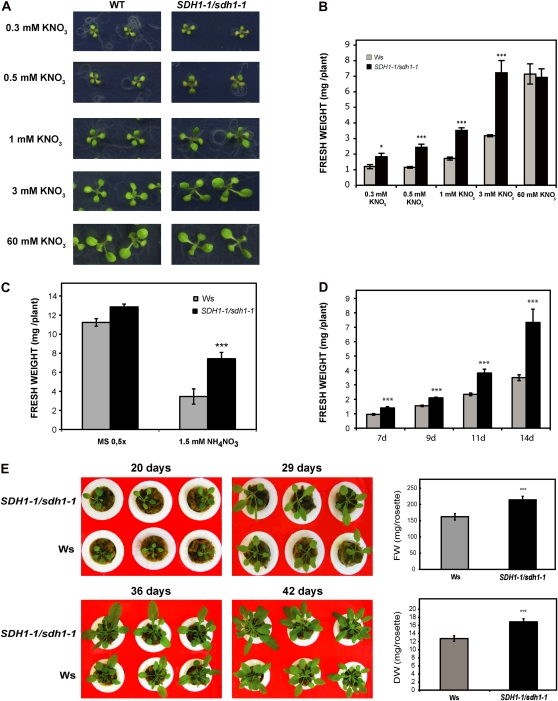Figure 7.
Effect of SDH deficiency on growth under low-nitrogen conditions. A and B, Photographs (A) and biomass (B) of 15-d-old wild-type (WT; light gray bars) and SDH1-1/sdh1-1 mutant (black bars) seedlings grown under axenic conditions on medium containing different concentrations of potassium nitrate. Eight independent shoot pools were weighed for each genotype and condition, and values (fresh weight per plant) are presented as means ± se. C, Biomass of 15-d-old shoots grown on medium containing NH4NO3. Seedlings were grown on solid medium containing either 1.5 mm NH4NO3 or 9.4 mm KNO3 + 10.3 mm NH4NO3 (0.5× MS). Fresh weights of eight biological replicates, each containing six to 25 shoots, were determined per genotype. D, Growth kinetics was analyzed by growing wild-type and SDH1-1/sdh1-1 mutant seedlings in solid medium containing 3 mm KNO3 and 1% Suc for the indicated times (in days). Fresh weights of eight biological replicates, each containing three to 20 shoots, were determined per genotype and time of growth. E, Improved growth of SDH-deficient plants grown hydroponically. Stratified seeds were sown on 0.5× MS (with 1% Suc) and, after 11 d in a 16-h/8-h day/night cycle, seedlings were transferred and grown hydroponically at 22°C under an 8-h-light/16-h-dark cycle. Twenty-day-old plants, 29-d-old plants, 36-d-old plants, and 42-d-old plants were photographed, and images of three representative plants per genotype are shown. Rosette fresh weight (FW) and dry weight (DW) of individual 42-d-old plants were determined: values presented are means ± se of 12 individual plants per line. Results show that the size increase in mutant plants is maintained throughout growth. Asterisks indicate values that were determined by t test to be significantly different from the wild type (* P < 0.05, *** P < 0.01).

